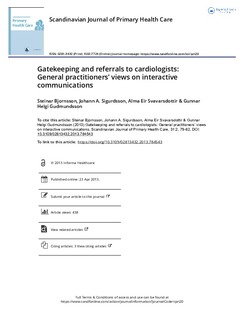Gatekeeping and referrals to cardiologists: General practitioners' views on interactive communications
Journal article, Peer reviewed
Published version

View/
Date
2013Metadata
Show full item recordCollections
Original version
Scandinavian Journal of Primary Health Care. 2013, 31 (2), 79-82. 10.3109/02813432.2013.784543Abstract
Objective. Referrals to specialists have not been compulsory in Iceland since 1984. In 2006, referrals were again required for patients to receive reimbursement for part of the cost of appointments with cardiologists. The aim of this study was to explore GPs’ attitudes to the referral system and possible professional gain by interactive communications. Design. Cross-sectional questionnaire survey. Setting, subjects, and main outcome measures. This is part of a larger study in 2007 on referrals from GPs to cardiologists. A questionnaire was sent to all working GPs in Iceland (n = 201 and responsible for 307 000 inhabitants) regarding the referral process, reasons for referrals, how often a response letter was received, and GPs’ attitudes to the referral system. Responses from doctors working in rural areas were compared with those working in Reykjavik and nearby urban areas. Results. The response rate was 63% (126 answers). The mean age of participants was 51; 89% were GP specialists and 60% worked in Reykjavik and nearby urban areas. Almost all respondents (98%) thought that report letters from cardiologists were helpful; 64% (95% confidence interval 53–73) thought that the recently introduced referral system did increase useful information that was beneficial to their patients. There was a statistically significant difference between colleagues working in rural areas and those working in Reykjavik and nearby urban areas regarding several aspects of the referral process. Conclusion. A referral system increases the flow of information and mutual communications between general practitioners and specialists to the benefit of the patients. The geographical location of the health care centre may be of importance regarding the value of the referrals.